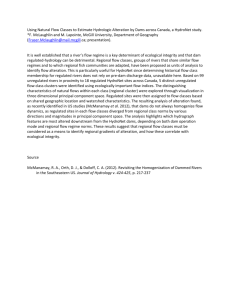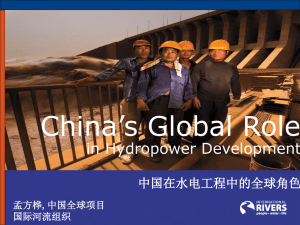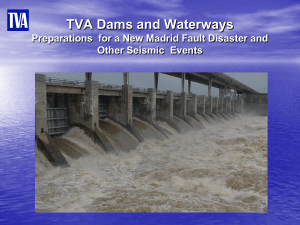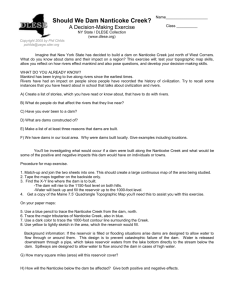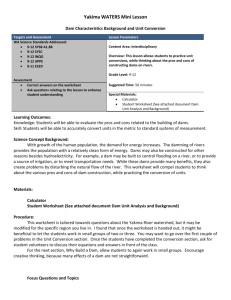Water Use and Management Notes with Blanks
advertisement
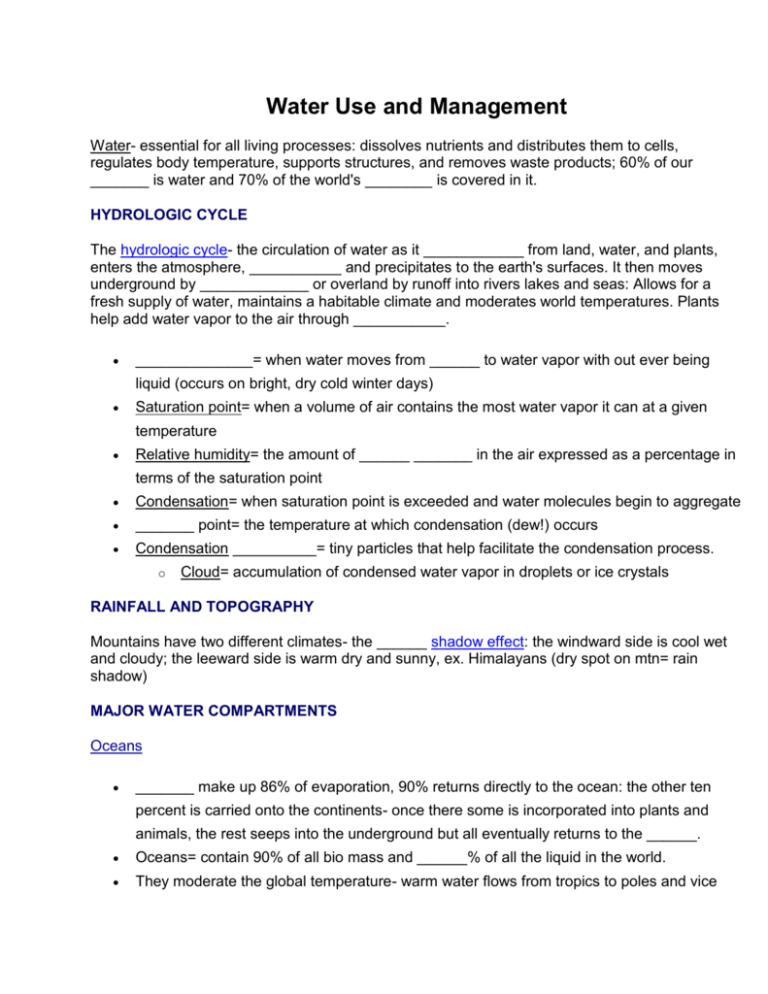
Water Use and Management Water- essential for all living processes: dissolves nutrients and distributes them to cells, regulates body temperature, supports structures, and removes waste products; 60% of our _______ is water and 70% of the world's ________ is covered in it. HYDROLOGIC CYCLE The hydrologic cycle- the circulation of water as it ____________ from land, water, and plants, enters the atmosphere, ___________ and precipitates to the earth's surfaces. It then moves underground by _____________ or overland by runoff into rivers lakes and seas: Allows for a fresh supply of water, maintains a habitable climate and moderates world temperatures. Plants help add water vapor to the air through ___________. ______________= when water moves from ______ to water vapor with out ever being liquid (occurs on bright, dry cold winter days) Saturation point= when a volume of air contains the most water vapor it can at a given temperature Relative humidity= the amount of ______ _______ in the air expressed as a percentage in terms of the saturation point Condensation= when saturation point is exceeded and water molecules begin to aggregate _______ point= the temperature at which condensation (dew!) occurs Condensation __________= tiny particles that help facilitate the condensation process. o Cloud= accumulation of condensed water vapor in droplets or ice crystals RAINFALL AND TOPOGRAPHY Mountains have two different climates- the ______ shadow effect: the windward side is cool wet and cloudy; the leeward side is warm dry and sunny, ex. Himalayans (dry spot on mtn= rain shadow) MAJOR WATER COMPARTMENTS Oceans _______ make up 86% of evaporation, 90% returns directly to the ocean: the other ten percent is carried onto the continents- once there some is incorporated into plants and animals, the rest seeps into the underground but all eventually returns to the ______. Oceans= contain 90% of all bio mass and ______% of all the liquid in the world. They moderate the global temperature- warm water flows from tropics to poles and vice versa ____________ time= that length of time an individual molecule spends circulating in the ocean before evaporation, on average its ________ years Glaciers, Ice and Snow Glaciers hold almost ______% of the earth's freshwater. These frozen rivers slowly move downhill. Antarctic glaciers contain 85 % of all the ice in the world. However unless the glaciers melt the water is hard to access for our use! Groundwater Ground water= holds the second largest amount of ______ water Infiltration= _______ _________ runs through fractures of the rocks in the soil Zone of ____________= upper soil layers that hold both air and water, moisture for plant growth comes from here. The depth varies. Zone of _____________= lower levels where all soil air spaces are filled with water. The top of the zone is called the ________ table and it is neither flat nor stationary. Aquifers: _________ layers of sand etc. below water table. ex. Ogallala Aquifer Artesian well: water gushes out without being ________ SHOULD WE REMOVE DAMS? YES! Storage reservoirs drown free-flowing rivers. Set the rivers free! They can submerge ________, farms, and cemeteries and important __________ sites Block fish migration- esp. ________ migration routes impeded Can change aquatic habitats that were important to species ____________ of reservoir behind dam builds up requiring dredging. Nutrients carried within the silt and clay are lost to down stream ___________ that would normally be deposited during floods. Silts can be replaced with commercial __________ costing more than 100 million dollars a year! Dam _________ could devastate communities living downstream. Main problem with dams are their inefficiency!!! Dams lose water through ____________, and seepage through porous _______~~~> wasting more water than they make available. Accumulating sediments can _________ reservoirs and make dams completely useless NO! Stores water, and generates ________ Creates jobs for workers Help economic development Allows arid and unfarmable lands to grow crops through _________ of water LOSS OF FREE-FLOWING RIVERS Hetch Hetchy Valley in Yosemite National Park: San Francisco wanted to dam the Tuolumne River in the park to produce hydroelectric power and provide water for the city. Some people liked it because it supported clean water and power. John ________ opposed the dam project (He founded the Sierra Club and Yosemite Park!! Wahoo!) He said that Hetch Hetchy valley's beauty should be protected. The people fought a hard fight but the dam builders won. Other famous dam disasters include the James Bay Project in ________ which diverted 3 rivers into the Hudson Bay. The year after it was built 10,000 _________ drowned trying to follow their migration routes. :( Also mercury is seeping into the water from the bedrock and entering the food chain. Waa. TVA- Tennessee Valley Authority built the Tellico Dam. Construction was halted when dam threated the life of an _____________ species- the snail darter. Supreme Court ruling said move the fish and finish the dam! Presently the ___________ are building a dam on the Three Gorges section of the Yangtze river right on an active________. Dam__! WATER MANAGEMENT AND CONSERVATION Goal: prevent _______ damage and store water for future use instead of building dams and reservoirs. Watershed- also known as a "catchment" or drainage basin is all the land drained by a stream or river. Retaining ____________ in watersheds help hold back rainwater and decrease downstream floods. More environmentally sound farming and forestry techniques can help reduce runoff. Retaining crop ______ on fields can reduce flooding Minimizing _______ and forest cutting on _______ slopes protect watersheds Conserving wetlands helps preserve natural water storage capacities and aquifer recharge zones. Droughts occur in the US on a thirty year cycle DOMESTIC CONSERVATION How can we help stop water shortages? Take shorter ________!! Stop leaks!! Efficiently wash your cars, dishes, and clothes!!! What about appliances? Use _____-volume showerheads, toilets and efficient dishwashers and washing machines!! If you plant native ground cover in a "natural lawn" or make a rock garden, landscape in harmony with the surrounding environment- xeriscaping (choosing plants that require little _________) can be great instead of constantly watering and feeding a dry, arid garden.*** :0) Our biggest domestic water use is _______ flushing!! eeeew. o We use about 13,000 gallons of drinking quality water annually to flush toilets. o People are now creating low-volume and waterless toilets. RECYCLING AND WATER CONSERVATION In 3rd world countries _______% of all the agricultural water used is lost to leaks in irrigation canals, application to areas where plants don't grow, runoff, and evaporation. Farmers have been starting to turn to new farming techniques such as leaving crop residue on fields and ground cover on drainage ways, using mulches, and low-volume irrigation in order to reduce water losses. Drip _________= AWESOME! It applies water ________ to plant ________, but its very expensive. Used on only 1% of farmland worldwide. Desalinization of water is _____________ . PRICE MECHANISMS AND WATER POLICY In the past, water policies have been against conservation. Some parts of the US were based on riparian use rights= people who lived near a ________ could use as much as they wanted as long as they didn't taint its quality or the limit others who wanted to access to the water down stream. In many places, like ________, water used to be very cheap. People didn't have any incentive to repair leaks, or restrict usage. The _________ of 1988 changed all of these practices... The US is currently saving 38 million gallons a day compared to per capita rates 20 yrs ago. However, we have 10% less water because of the growing population! Charging higher proportion of costs to users of public water projects~~~> encourages conservation!




